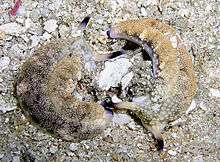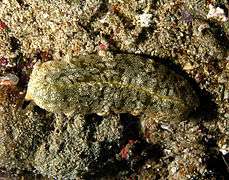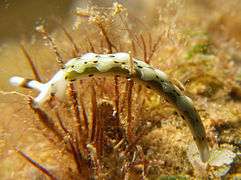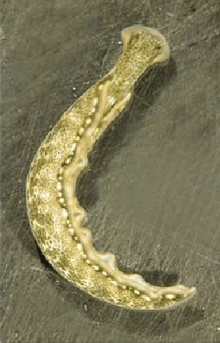Plakobranchidae
Plakobranchidae is a family of sea slugs, marine opistobranch gastropod mollusks in the superfamily Plakobranchoidea. They superficially resemble nudibranchs but they are sacoglossans, members of the clade Sacoglossa within the Opisthobranchia.[2]

| Plakobranchidae | |
|---|---|
 | |
| A live individual of Elysia crispata, head end towards the lower right | |
| Scientific classification | |
| Kingdom: | |
| Phylum: | |
| Class: | |
| (unranked): | |
| Superfamily: | |
| Family: | Plakobranchidae |
| Synonyms | |
| |
Taxonomy
Elysiidae was originally described as "Elysiadae" by Forbes & Hanley in 1851 in the book A history of British Mollusca and their Shells 3:613. In the taxonomy of Bouchet & Rocroi (2005), the family Elysiidae is considered to be a synonym of the family Plakobranchidae Gray, 1840.
The original spelling Placobranchidae, based on Placobranchus, an incorrect subsequent spelling by Férussac (1824) in a translation of van Hasselt's work. Franc (1968: 848) and Jensen (1996: 92) attributed the name to Rang, 1829 (p. 134), who used the vernacular "les Placobranches". Jensen (1997: 180-181) argued for the restoration of the spelling Plakobranchidae, and she has been followed by Wägele & Willan (2000: 91). Bouchet & Rocroi (2005: 133), argued that the spellings Placobranchus and Placobranchidae were in prevailing usage and were conserved under Art. 33.3.1. This view has been challenged by R. Burn and the spelling Plakobranchidae is now preferred.
This family has no subfamilies.
Genera
Genera in the family Plakobranchidae include:[3][4]
- Elysia Risso, 1818 - synonyms: Actaeon Rang, 1829; Elysiella Verrill, 1872; Elysiella Bergh, 1871; Pterogasteron Pease, 1860; Thridachia P. Fischer, 1883; Tridachia Deshayes, 1857; Tridachiella MacFarland, 1924
- Elysiobranchus Pruvot-Fol, 1930
- Pattyclaya Marcus, 1982
- Plakobranchus van Hasselt, 1824 - type genus, the author have spelled it originally as Plakobranchus, but name Placobranchus has a long time been in prevailing usage. Synonym: Placobranchus Hasselt, 1824.
- Thuridilla Bergh, 1872
_cropped.jpg)


_sur_Codium_fragile_(Suringar)_Hariot%2C_1889.jpg)
- Thuridilla moebii
References
- Gray J. E. (1840). Shells of molluscious animals. In: Synopsis of the contents of the British Museum, ed. 42: 121, 148.
- Gofas, S. (2012). Plakobranchidae. Accessed through: World Register of Marine Species at http://www.marinespecies.org/aphia.php?p=taxdetails&id=411960 on 2012-03-08
- Jensen K. R. (1996). "Phylogenetic systematics and classification of the Sacoglossa (Mollusca, Gastropoda, Opisthobranchia)". Philosophical Transactions of the Royal Society London B Biological Sciences 351(1335 ): 91-122. doi:10.1098/rstb.1996.0006.
- Händeler K., Grzymbowski Y. P., Krug P. J. & Wägele H. (2009) "Functional chloroplasts in metazoan cells - a unique evolutionary strategy in animal life". Frontiers in Zoology 6: 28. doi:10.1186/1742-9994-6-28 PMID 19951407.
External links
| Wikimedia Commons has media related to Plakobranchidae. |
